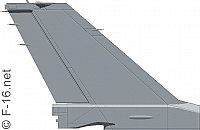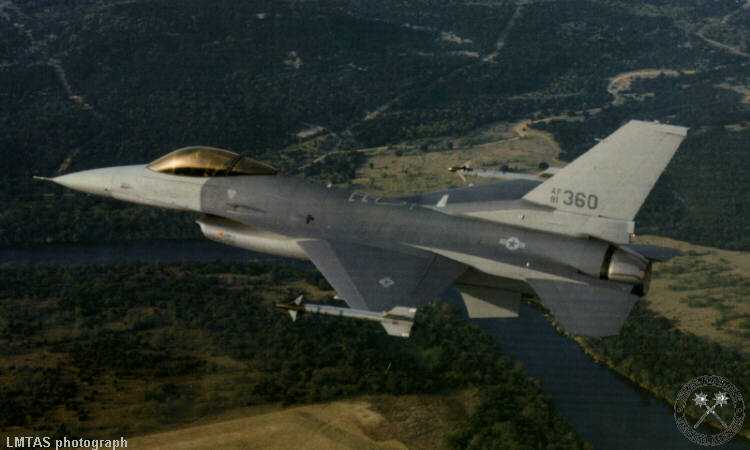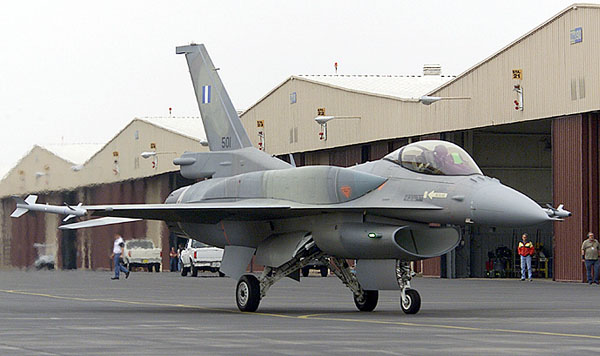History
The Block 50/52 is the current production version of the F-16 Fighting Falcon. It features the Improved Performance Engines, either the F110-GE-129 for the block 50 or the F100-PW-229 for the block 52. The F100-PW-229 is lighter and more powerful than earlier F100s, and had been flying at Edwards AFB since mid-1990 in test ship #81-0816. Both engines are rated at 29,000lbs of thrust (129kN).
This version first appeared in late 1990. It was unofficially designated F-16CJ/DJ for the same reason as the Block 40/42 unofficial designation. The first Block 50/52 F-16 rolled out of the Fort Worth facility on October 31, 1991 (#90-0801). Production of this version is still ongoing and will be expanded well beyond 2005 with the latest aircraft delivered to Greece and Israel.
Structure & Avionics
The standard avionics fit for the Block 50 includes:
- Honeywell H-423 Ring Laser Gyro Inertial Navigation System (RLG INS) for rapid in-flight alignment;
- GPS receiver;
- Data Transfer Cartridge with a larger capacity (128KB) to accommodate the planned avionics growth;
- Improved Data Modem for faster data transmission;
- AN/ALR-56M advanced RWR;
- AN/ALE-47 threat adaptive countermeasure system;
- digital terrain system data transfer cartridge;
- cockpit compatible with night vision systems;
- advanced IFF interrogator;
- Upgraded Programmable Display Generator (UPDG);
- MIL-STD-1760 data bus for programming new-generation PGMs;
- Horizontal Situation Display (HSD) for increased situational awareness and tactical flexibility on all missions.
The Block 50/52 also carries the Westinghouse AN/APG-68 V(5) radar, which offers longer range detection against air targets and higher reliability. The radar has a programmable signal processor that employs very high-speed integrated circuit (VHSIC) technology. The latest batches of Block 50/52 carry the same radar, but versions V(7) and V(8), which offer even greater performance envelopes. The VHF/FM antenna is now incorporated into the leading edge of the vertical fin and has an extended operating distance. The cockpit also includes 2 monochrome MFD's (soon to be replaced by the MLU's color displays) and a FOV HUD.
The Block 50's have the capability to fire the AIM-120 AMRAAM, the new AGM-65G Maverick missile and the PGU-28/B 20mm cannon round. The Block 50/52 is capable of carrying the new JDAM munition, the AGM-154A/B JSOW and is the first F-16 version to integrate the AGM-84 Harpoon antishipping missile. The AGM-137 TSSAM stand-off attack missile was also foreseen in its weaponry, but subsequently cancelled. The aircraft can launch the Harpoon in line-of-sight, bearing-only, and range/bearing modes. The addition of the Harpoon gives the F-16 a significant standoff range anti-shipping capability, especially when combined with optional 600-gallon fuel tanks.
The first Block 50 F-16 was delivered to the USAF in November of 1991. Over 300 have been delivered by early 1997, to four different customers. New production Block 50/52 aircraft ordered after 1996 also include selected features from the MLU program: color multifunction displays, a three-channel video tape recorder, and the modular mission computer.
Modifications & Upgrades
Wild Weasel

The F-16CJ/DJ Block 50D/52D have the HARM avionics/Launcher Interface Computer (ALIC) resulting in a full autonomous employment capability of the HARM missile. This capability adds the SEAD (Suppression of Enemy Air Defenses) mission to the already extensive list of missions the F-16 is capable to perform.
The aircraft features full integration for the advanced AGM-88 HARM II and Shrike anti-radiation missiles, a Lockheed Martin Pave Penny laser ranger pod and the Texas Instruments (now Raytheon) AN/ASQ-213 HTS (HARM Targeting System). The pod is mounted on the starboard intake hardpoint and contains a super-sensitive receiver that detects, classifies, and ranges threats and passes the information to the HARM and to the cockpit displays. With the targeting system, the F-16CJ/DJ has full autonomous HARM capability. The HTS pod can be omitted however - in that case, RC-135 Rivet Joint aircraft support the F-16 in sorting and prioritizing targets in dense threat environments.
Two HARM missiles are normally carried on a typical SEAD mission, however, 4-missiles loads are currently being test-flown at Eglin AFB.
Deliveries of the Block 50D/52D began in May 1993. All but the earliest Block 50 models have been upgraded to Block 50D standard.
Block 50/52 Plus
The Block 50/52 Plus is a version which has special provisions for the adverse weather delivery of the Boeing JDAM (Joint Direct Attack Munition). The update includes an add-on tail unit containing a synthetic aperture radar, providing guidance to 1,000lbs Mk.83, 2,000lbs Mk.84 and the 2,000lbs BLU-109 warhead. Other features include passive missile warning, terrain-referenced navigation, and provisions for the 600 US gal (2,271 litre) external fuel tanks and conformal fuel tanks.
Other features of the aircraft include an on-board oxygen generating system (OBOGS), the AN/APX-113 advanced electronic interrogator/transponder IFF system, helmet-mounted cueing system (HMCS), ASPIS internal electronic countermeasures suite (full provisions), the Northrop Grumman APG-68(V)9 radar, which is the latest version of the F-16C/D radar. This radar features significant improvements in detection range, resolution, growth potential, and supportability. Furthermore, application of advanced processing techniques enhances the radar's ability to operate in dense electromagnetic environments and resist jamming better than all previous models.
The V(9) version of the AN/APG-68 radar provides both improved air-to-air capabilities and air-to-ground capabilities. These include:
- 30 percent increase in detection range;
- Improvements in false alarm rate and mutual interference;
- Four versus two tracked targets in the Situation Awareness mode (a search-while-track mode);
- Larger search volume and improved track performance in Track While Scan mode;
- Improved track performance in Single Target Track mode;
- Two-foot resolution in new Synthetic Aperture Radar (SAR) mode, which allows autonomous delivery of precision, all-weather, standoff weapons;
- Increased detection range in Sea Surveillance mode;
- Improved target detection and map quality in Ground Moving Target Indication mode.
In general, this radar offers a 5X increase in processing speed and 10X increase in memory compared to the current AN/APG-68 radar and provides large growth potential.
The first production V(9) radar, which was delivered in April 2002, will be installed in the first Greece Block 52+ F-16. Also the new Israeli F-16s will be equiped with it.
The latest Israeli F-16 block 52 will furthermore be equiped with a video data link and Conformal Fuel Tanks manufactured by Israel Aircraft Industries (IAI), advanced avionics and a helmet-mounted display manufactured by Elbit, an advanced electronic warfare suite manufactured by Elisra and advanced weapons and sensors manufactured by Rafael. This makes these aircraft are becoming more and more an Israeli domestic product.
Production
Production of the block 50/52 totals 813 airframes up to now. Manufacturing started in 1991 and is still ongoing. Block 50 aircraft were delivered to the USAF, Turkey, Greece and Chile, whilst Block 52 aircraft were delivered to the USAF, South Korea, Singapore, Greece, Poland and Israel. Of the total number of Block 50/52, still 260 are waiting delivery to the customer (July 2003).
Specifications (standard Block 50/52)
Engine: One Pratt & Whitney F100-PW-229 turbofan, rated at 17,000 lb.s.t. dry and 28,500 lb.s.t. with afterburning or one General Electric F110-GE-129 turbofan, rated at 17,155 lb.s.t. dry and 28,984 lb.s.t. with afterburning.
Performance: Maximum short-endurance speed: Mach 2.05 (1353 mph) at 40,000 feet. Maximum sustained speed Mach 1.89 (1247 mph) at 40,000 feet. Tactical radius (hi-lo-hi interdiction on internal fuel with six 500-lb bombs) 360 miles. Maximum ferry range 2450 miles with maximum external fuel (excluding 600gal. tanks or CFT's) .
Dimensions: wingspan 31 feet 0 inches, length 49 feet 4 inches, height 16 feet 8 1/2 inches, wing area 300 square feet.
Weights: 18,238 pounds empty, 26,463 pounds normal loaded (air-to-air mission), 42,300 pounds maximum takeoff.
Sources
- Lt. Carl Krittenden.
Please use this form to add any list any error or omissions you find in the above text.
Note: your comments will be displayed immediately on this page. If you wish to send a private comment to the webmasters, please use the Contact Us link.



